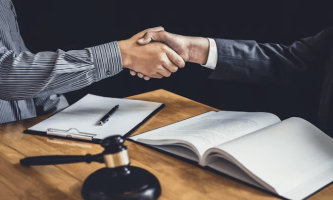Navigating Real Estate Transactions: The Crucial Role Of A Skilled Lawyer

In the tricky world of actual estate transactions, having a knowledgeable manual utilizing your aspect is vital. Only a skilled lawyer can help you in getting out of this situation. Additionally, real estate transaction cases are quite complicated in nature.
So, you must seek the assistance of an expert lawyer to deal with your case with ease. Your lawyer knows the state law and can help you get over this situation with complete ease.
Real property attorneys play a pivotal function in ensuring an easy and legally sound assets deal.
As we delve into the jobs and responsibilities of those prison professionals, it turns glaring that their understanding is critical in navigating the complexities of real estate transactions.
The Key Roles Of A Real Estate Lawyer
There are certain key roles of a real estate lawyer that you need to be well aware of before you seek their assistance. Some of the key roles of a real estate lawyer are as follows:-
1. Contract Review And Drafting
Drafting contracts and careful analysis are one of the main obligations of a real estate legal practitioner. These legal practitioners examine each detail, ensuring that the phrases are truthful and protective of their client’s interests.
A well-prepared agreement sets the path for a successful and stable transaction, with minimal possibilities of disputes further on. This will become possible when you seek the assistance of an experienced lawyer.
2. Due Diligence
Real estate legal professionals engage in thorough due diligence to unearth any ability felony troubles related to belongings. From investigating identity and possession to figuring out liabilities, their paintings are critical in preventing surprises during the transaction manner.
This meticulous exam ensures that the client is aware of the property’s criminal standing. Your lawyer will check everything on your behalf, and this will help you to get the correct value of your property.
3. Negotiation Support
Negotiating the terms of an actual property deal can be a sensitive dance. A skilled actual estate lawyer acts as a precious best friend in the course of negotiations, advocating for their consumer’s hobbies.
Whether it’s addressing concerns or proposing amendments to the contract, their role is pivotal in accomplishing an honest and fine agreement.
4. Coordinating With Other Professionals
Real estate transactions contain collaboration with various professionals, including real property marketers, lenders, and title agencies. An actual estate lawyer serves as the coordinator, making sure of seamless communique and cooperation during these events. This collaboration is important for a properly organized and a hit remaining manner.
5. Document Preparation And Review
As with the last-date technique, an actual property legal professional takes a fee for preparing and reviewing vital legal documents.
From deeds to mortgage papers, their meticulous exam ensures the accuracy and legality of each report, reducing the likelihood of final disputes.
Your real estate lawyer is good enough to prepare and review the documents that are crucial for closing the real estate agreements. This is one of the essential aspects of real estate transactions.
How Real Estate Lawyer Resolves Legal Issues And Disputes
There are several ways legal issues and disputes can be resolved with the help of a skilled lawyer. You must be well aware of the scenarios that can assist you in reaching your requirements with complete ease.
A. Addressing Title Defects
Title defects can be a stumbling block in real property transactions. Real property legal professionals specialize in figuring out and resolving these problems, ensuring a clear and marketable title for the client.
Their understanding is important in mitigating dangers related to undisclosed liens or ownership disputes.
Read Also: Real Estate Mobile App Development: Detailed Manual
B. Handling Contract Disputes
On the unlucky occasion of an agreement dispute, a real estate attorney steps in to navigate the resolution method. Whether via negotiation, mediation, or criminal action, they aim to defend their customer’s pastimes and discover a first-class resolution to the war.
Only an experienced and effective lawyer can help you to get rid of this situation. A skilled lawyer knows what actions to take in this type of scenario.
C. Compliance With Local Regulations
You can maintain compliance with local regulations. Therefore, you must be well aware of the scenarios about some of the legal compliance you must follow. There are certain key steps behind it.
It is essential to navigate the local regulations with the help of a skilled lawyer before you fall into a trap of local regulations. Your lawyer has the expertise to handle these cases with complete care and accuracy to pull you out of the problem.
D. Staying Informed About Local Laws
Real property legal guidelines range through place, and staying knowledgeable about neighborhood regulations is a key duty of a real estate attorney.
This includes compliance with zoning laws, land-use guidelines, and every other criminal nuances unique to the location. Their information guarantees that the transaction aligns with the relevant legal guidelines.
E. Dealing With Environmental Concerns
Environmental issues can appreciably impact real estate transactions. Real property lawyers plan to cope with and mitigate those concerns, navigating environmental rules to defend their patron’s pursuits.
This proactive approach minimizes the hazard of prison challenges associated with environmental elements. You just have to follow the directives of your lawyer to avoid any kind of environmental discrepancies and reduce environmental concerns.
Communication With Clients
Try to maintain smooth communication with your clients so that the process of communication becomes smoother with them. Some of the key factors that you should know here are as follows:-
1. Keeping Clients Informed
Effective communique is at the center of a real estate attorney’s role. Regular updates on the progress of the transaction maintain customers’ knowledge and alleviate worries. This obvious conversation fosters agreement with and guarantees that customers are actively concerned in a selection-making manner.
2. Educating Clients On Legal Aspects
Real estate transactions contain complicated criminal terminology and approaches. A real property attorney takes the time to teach their clients, empowering them to make informed selections. By demystifying felony jargon, they allow customers to navigate the transaction with self-belief.
Which Legal Aspect Can Affect Real Estate Transactions?
There are several legal aspects that can affect real estate transactions that you must be well aware of. Some of the key aspects that you should be well aware of are as follows.
1. Title Disputes
Title disputes are one of the most frequent issues of real estate transactions. All these disputes happen when conflicting claims of complete ownership exist. Unresolved liens and errors in public records can make things worse for you.
It may also happen that your previous owner has taken a second mortgage on the property without documenting it properly. Thus, the new owner will be left with some unexpected debts. There can also be disputes over the boundaries of the property. You must identify these facts while reaching your goals with ease.
2. Contract Breaches
Contract breaches fail as either party fails to fulfill the obligation. Most of the time, these are outlined in the process of the real estate agreement. Common breaches lead to failure of closing time. Thus not adhering to inspection contingencies.
There can be situations where sellers may fail to disclose some of the known issues. It can lead to a leaky roof, or it can lead to termite damage. This can also lead to some of the significant costs while having the buyer down the line.
3. Zoning Issues
Financing forms a critical component for every real estate transaction as well as complications. This can arise from the process of loan approvals, appraisal discrepancies, and changes in interest rates.
You must secure the loan approval process based on the initial approval process. Thus, it can lead to the scrambling of property in order to reduce the risk of losing the property. It is one of the vital legal aspects of real estate transactions.
4. Financing Complications
Financing is one of the critical components of the real estate transaction, as complications can arise from loan approvals. Suppose you want to get the loan approvals on the basis of your initial appraisal. Then, the lender of the loan approval is based on the initial assessment.
You must avoid the financial complications that can make the process of financial transactions easier in all possible means. Additionally, you need to identify the best options that can assist you in getting things done in perfect order.
5. Property Defects
Undisclosed property defects can lead to legal disputes. Sometimes, homeowners, in order to sell their property at a high price, hide the defects of their property. This is actually a wrong practice, and if the purchaser of the property spots any of such defects after being sold. Then, the chances of legal disputes increase.
So, try to avoid any kind of disputes in real estate transactions that can lead to long-term problems for you. Additionally, you must be well aware of the situations that can make things easier for you in the long run.
Conclusion
In the problematic dance of real property transactions, a skilled real estate legal professional is the guiding accomplice you want.
From contract evaluation and negotiation help to facilitating the final method and resolving criminal issues, their roles are diverse and vital.
For a steady and seamless transaction, click here and hire Olschewski Davie, your trusted companion in real property law. With their experience and dedication, you may navigate the complexities of real property transactions with confidence and peace of mind.
Read Also:
















